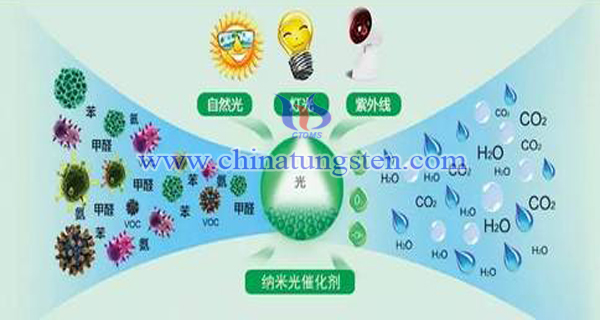A Photocatalyst Material for the Degradation of Synthetic Dye Contaminants
- Details
- Category: Tungsten Information
- Published on Monday, 30 July 2018 18:12
It is well known that in addition to titanium dioxide, tungsten trioxide is one of the most studied photocatalyst materials in recent years. Due to the introduction of nanotechnology, the photocatalytic performance of tungsten trioxide has been greatly improved. A photocatalyst is a substance that stimulates a reaction by absorbing light without changing before or after the reaction. The photocatalyst has the ability to absorb energy in sunlight, prevent infection and disease outbreak by destroying bacteria and provides disinfection, and purifie water and air.
As time went on, scientists have constantly verified the above theory. Recently, scientists at a university in the United States published their new results in the journal Nature Science, a new type of composite material that is expected to be a photocatalyst for the degradation of environmentally harmful synthetic dye contaminants, which will be purified at least annually. Nearly 300,000 tons of industrially produced wastewater could be treated with this new technique.

This new, harmless photocatalytic material effectively removes dye contaminants from water, absorbs more than 90% of the dye toxins, and uses visible light to increase the dye decomposition rate by nearly ten times that of conventional titanium dioxide.
Their discovery was to synthesize the composite by heating the reaction mixture under high pressure in a sealed vessel and by growing ultrathin "nanowires" of tungsten trioxide on the surface of the tantalum nitride particles. Since the size of the two material components is unbelievable, the diameters of tantalum nitride and tungsten oxide are generally less than 40 billionths of a meter, so the composite provides a large specific surface area for dye capture, and then the material continues to use sunlight. The energy breaks down the dye into smaller, harmless molecules called "photocatalytic degradation." After removal of the hazardous dye, the catalyst can simply be filtered from clean water and reused.
Exciting new materials can easily remove artificial dye contaminants from water under solar energy. Under the illumination of white light, Rhodamine B dye is tested. The photocatalytic degradation efficiency of the composite reaches 93.6%, which is very powerful.
Researchers believe that although photocatalytic degradation of dyes has been studied for decades, researchers have recently developed materials that absorb the visible portion of the solar spectrum. Other materials such as titanium dioxide can also decompose dyed solar energy, but their efficiency is limited. Because they only absorb higher energy UV rays, or it can be said that the band gap of titanium dioxide is too wide, and only 5% of the light energy activates titanium dioxide to work.
The materials the researchers said are tantalum and tungsten. This is the hottest photocatalytic star in recent years. Tungsten oxide is considered to be one of the most promising materials for a range of photocatalytic applications due to its high electrical conductivity, chemical stability and surface activity, and strong absorbance. As a low bandgap semiconductor, tantalum nitride is red due to its ability to absorb the entire spectrum of visible light, so a large amount of energy is extracted from sunlight to drive the degradation process.
However, the true potential of these two materials can only be achieved after they are combined into one composite. Due to the electronic exchange between the two materials, the test dye used in the study was perfectly decomposed by the composite, and its final performance was about twice that of tantalum nitride itself, along with other major photocatalytic materials (many of which are for humans and aquatic organisms). Both are toxic. In contrast, tungsten-rhenium composites are classified as harmless materials.
The scientists responsible for the study believe that their current research only discovers the potential of materials, and now they have demonstrated the function of the composite, and the next goal is not only to further improve the material, but also to expand its practical application. Explore the feasibility of other areas, such as photocatalytic decomposition of water to produce hydrogen, used to produce solar materials for clean hydrogen fuels.
- Tungsten Manufacturer & Supplier, Chinatungsten Online: www.chinatungsten.com
- Tungsten News & Prices of China Tungsten Industry Association: www.ctia.com.cn
- Molybdenum News & Price: news.molybdenum.com.cn
- Tel.: 86 592 5129696; Fax: 86 592 5129797; Email: sales@chinatungsten.com



 sales@chinatungsten.com
sales@chinatungsten.com